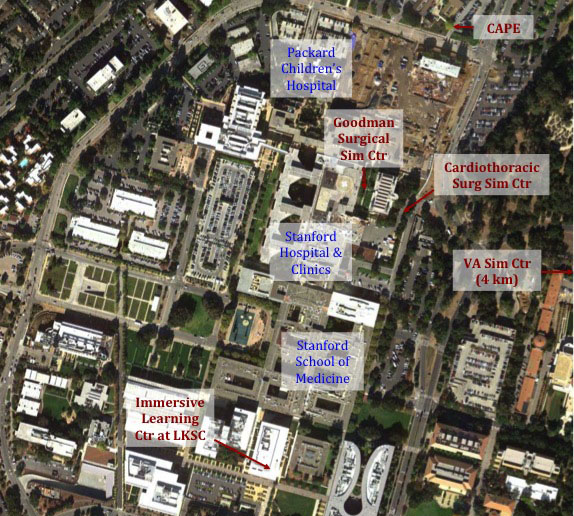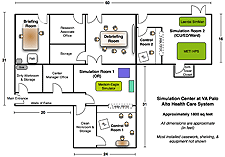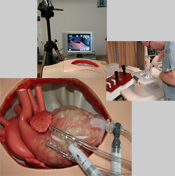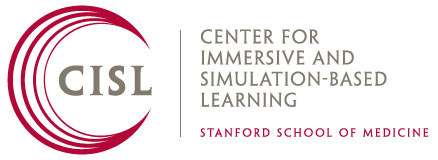CISL Affiliate Centers
In addition to the Goodman Immersive Learning Center and in situ activities conducted within SUMC hospitals, Stanford has several core simulation groups and a number of simulation facilities.
Patient Simulation Center of Innovation, VA Palo Alto
The Simulation Group at VA Palo Alto is the pioneering inventor of modern mannequin-based patient simulation. They performed their first pilot-test simulations in 1986, and have had a dedicated simulation center since 1995. Besides inventing the modern simulator technology they are responsible for introducing the current paradigm of high fidelity simulations addressing both behavioral and teamwork skills as well as technical/medical skills, adapting many concepts and practices from those used in commercial aviation simulations.
Originally concentrating on anesthesiology – the field of pioneers Gaba, Howard, Fish (and now including Drs. Harrison, Fanning, and Mudumbai), the Group has expanded to include Stanford faculty working on simulation in Intensive Care and Rapid Response Teams (Lighthall, Barr, Geller, Bertaccini), Emergency Medicine (Harter and Smith-Coggins), Respiratory Therapy (Miller and VA Palo Alto RT staff). A spin-off group in pediatric anesthesia (Chen, Edler, Honkanen, Williams, Hackel) conducts simulation training in actual clinical work environments. This group also conducts research on performance assessment and on testing of human factors of medical devices and procedures using simulation.
This Group a long-standing dedicated simulation center. Currently occupying around 2200 square the VA Simulation Center has 2 large simulation rooms – one set up as on operating room and one as an ICU, ED, or Ward. This Center has 5 simulators – 3 permanently set-up and 1 adult simulator for “in-situ” training exercises in actual clinical environments. The VA group provides the infant simulator to the pediatric anesthesia simulation team.
![]() Patient Simulation Center Fact Sheet
Patient Simulation Center Fact Sheet
Center for Advanced Pediatric and Perinatal Education (CAPE)
Work on neonatal and pediatric simulation began in the late 1990s by Lou Halamek, MD at the VA Simulation Center (veterans have children and grandchildren too!). Philanthropy enabled the group to create the CAPE facility near the Lucile Packard Children’s Hospital at Stanford.
CAPE develops, conducts, and evaluates training in neonatalogy, perinatalogy (including combined-team training linking obstetrics, OB anesthesia, OB nursing, neonatal intensive care, and neonatal transport. CAPE has one large simulation room with two simulation bays and several different simulators (maternal and neonatal). CAPE also conducts research on simulation pedagogy and on human factors.
The Goodman Surgical Simulation Center
The Goodman Surgical Simulation Center, under the direction of James Lau, MD is located in close proximity to the operating room suites at Stanford Hospital. This center utilizes mannequin-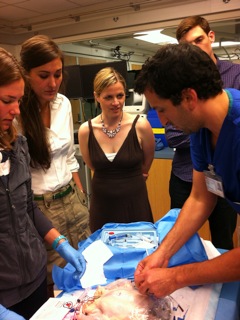 basedteam training, and offers a training program for laparoscopic surgery using part-tasktrainers. The ultimate goal is surgeons willrehearse an operation on a patient-specific palpable hologram that is digitally derived from models that are constructed from diagnostic imaging data and later,deliver the data set of that operation with robotic assistance.
basedteam training, and offers a training program for laparoscopic surgery using part-tasktrainers. The ultimate goal is surgeons willrehearse an operation on a patient-specific palpable hologram that is digitally derived from models that are constructed from diagnostic imaging data and later,deliver the data set of that operation with robotic assistance.
The Endovascular Simulation Program is housed in the Goodman Surgical Simulation Center under the direction of Jason T. Lee, MD. Beyond the Division of Vascular Surgery, the endovascular simulation program offers housestaff training and continuing medical education programs in cardiology and interventional radiology.
Cardiothoracic Surgery Simulation (CVS-Sim Center)
Located within the Falk Cardiovascular Research Center, the CVS-Sim Center contains thoracic models, arrested heart models, model for beating heart surgery, anastomosis and valve replacement task stations, intra-aortic balloon pump station, perfusion equipment, cardiovascular surgical instruments and supplies, operating table, video recording capability, porcine hearts for wet-lab, computer with educational DVD/CDs, and reference books and other educational materials. Based on a series of task/skill stations, wet-lab procedures, and environmental simulation, we have developed a comprehensive program intended to provide initial and follow-up simulation training and practice of cardiovascular surgery for the surgical resident.
The laboratory along with the CVS simulation course provides an environment for cardiac surgery and general surgery residents to practice cardiac surgical techniques and procedures. The simulation laboratory is designed to permit the resident to engage in a progressive experience; each task or sub-procedure is intended to allow the resident to demonstrate proficiency through direct tutoring and practice in the laboratory and in the simulated operating room. Directed by Drs. James I. Fann and Thomas A. Burdon, the CVS-Sim Center is a part of the Stanford Cardiothoracic Surgery curriculum.

